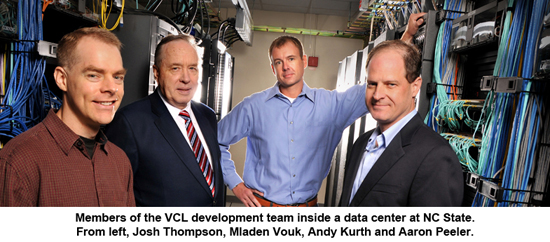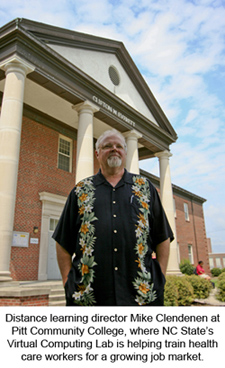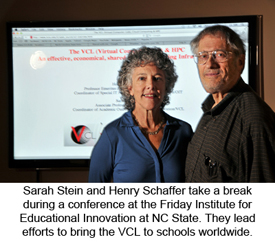CSC News
Ahead in the Clouds
Volume XII, Number 2, Fall 2012
 People still work with their hands in Pitt County, a largely agricultural community settled on rolling hills midway between North Carolina’s capital city and the Atlantic coast. Manufacturing plants dot the landscape, from the 1.5 million-square-foot DMS pharmaceutical facility in populous Greenville to the modest Package Craft corrugated box plant in Bethel, a crossroads village once said to be 16 miles from everywhere.
People still work with their hands in Pitt County, a largely agricultural community settled on rolling hills midway between North Carolina’s capital city and the Atlantic coast. Manufacturing plants dot the landscape, from the 1.5 million-square-foot DMS pharmaceutical facility in populous Greenville to the modest Package Craft corrugated box plant in Bethel, a crossroads village once said to be 16 miles from everywhere.But jobs are hard to come by in this fast growing county, where a 25 percent surge in population over the past decade has far outpaced economic opportunity.
“We’ve seen a lot of textile mills and manufacturing plants go away over the past few years,” says Mike Clendenen, a resident since 1965.
With the unemployment rate stuck at more than 10 percent for the past three years, life in the area can be a struggle, despite a mix of positive factors that landed Greenville–the county seat–on this year’s Forbes list of the best small places for business and careers.
Clendenen wants to make that distinction a reality in every corner of the county, from Fountain, where over a third of families fall below the poverty line, to Farmville, where churches outnumber retail shops in the historic downtown.
In his office on the campus of Pitt Community College in Winterville, where he’s director of distance learning and instructional technology, Clendenen plays a key role in helping students acquire new skills for a changing job market. It’s challenging work.
But thanks to cloud computing technology developed at North Carolina State University, students in one high-tech training program now have access to advanced software that would have been out of reach for many just a few years ago.
 Golden Opportunity
Golden OpportunityPitt Community College is a regional leader in a federally funded project to train thousands of health information technology professionals. The intensive six-month training program, offered entirely online, will help cure a shortfall of 50,000 IT workers needed by health care providers in the coming years as they introduce electronic medical records systems.
It’s a great match for Pitt County, where the largest employer is Vidant Medical Center, the teaching hospital for the Brody School of Medicine at East Carolina University. With a workforce of more than 6,000–including 500 physicians and 1,200 nurses–the medical center treats more than 33,000 inpatients and 266,000 outpatients a year.
Vidant launched its electronic health records system in 2007 and has since connected nine of its 10 medical centers to the database. Health providers nationwide must implement similar systems by 2015 to avoid penalties and qualify for Medicare incentives.
Since only 10 percent of physicians in the United States had a fully functioning electronic health records system as recently as 2009, and less than 2 percent of hospitals have integrated IT systems, the job possibilities are bright.
When the federal government set up a community college consortium to spearhead a nationwide training effort called the Health Information Technology (HIT) program, Pitt Community College went all in. By the fall of 2010 Pitt was leading the southern region, stretching from North Carolina to New Mexico, with a federal allocation of more than $20 million and a goal of training more than 10,000 workers a year.
Trouble on the Ground
The program was a no-brainer, says Clendenen, then the lead technology professional on the project. The cost was modest and students were given a tuition refund if they completed the course of study. The only problem was giving students access to the software used in the training program.
Among the 12 gigabytes of content provided by the government was an advanced simulation program that allows students to work on an actual electronic records database, the Veteran Administration’s VistA system. But, Clendenen quickly realized, the college had no practical way of getting the hefty program loaded onto students’ computers and no way of ensuring they’d have enough computing power to run it.
“After a couple of weeks, I said this is going to be a support nightmare,” Clendenen recalls. “Every time I tried to find a way around, it fell through for one reason or another.”
With just a few months to go before the launch of the training courses, Clendenen had a chance encounter with an NC State professor at an educational conference and found the solution to his dilemma. Rather than loading a copy of the VistA program on every student’s computer, Henry Schaffer told him, he could give students access over the Internet through a pioneering cloud computing system called the Virtual Computing Lab, or VCL.
Schaffer, professor emeritus of genetics and biomathematics at NC State, coordinates special information technology projects for the university. In the past few years he’s become an evangelist of sorts for the VCL, working with schools across the nation to either give them access to NC State’s network or help them set up one of their own.
Heaven Sent
Cloud computing is fast becoming the default method for remotely storing computer files that can then be easily accessed from a laptop, workstation, smartphone, tablet or virtually any Web-connected device.
NC State’s VCL is not only one of the first cloud computing systems ever developed, it’s cloud computing on steroids, enabling users to run software programs and operating systems that aren’t even installed on their computers.
Schaffer likes to demonstrate the power of the VCL by logging on with a 10-year-old Apple Macintosh computer. After entering his user name and password, Schaffer orders up a statistical analysis program called SAS/STAT running on Windows. In seconds, the familiar Windows start-up chime rings and the Windows logo appears on the Mac screen. From inside Windows, Schaffer opens the statistical program and begins entering numbers.
“Now the demo gets boring,” he says. “Now it can do what any computer can do.”
Even though SAS/STAT doesn’t come in a Mac-native version, it appears to run effortlessly on the Mac workstation. It doesn’t conflict with the Apple operating system because it isn’t actually running on the Mac, it’s running on a remote server somewhere deep inside a data center on campus.
At Pitt Community College, Clendenen found the system worked just as well with the VistA program that had given him so much trouble. Once he uploaded the program to the VCL, students in the training program could not only access the software from their own computers, they could actually run it using the VCL’s computing power. Even if their computer system lacked the minimum RAM or processing speed required for the program, VistA launched in the VCL and ran flawlessly.
Clendenen was amazed.
“I don’t notice much difference between running the program on the VCL and running it off my computer’s hard drive,” he says.
To prove the point he logs onto the VCL over the Internet, opens VistA and works with some medical records remotely. The simulation includes about 100 dummy patients, complete with a range of mock ailments, from diabetes to heart failure. Working on one of the program’s homework assignments, Clendenen prepares a report detailing a patient’s treatment history.
For Pitt Community College, the VCL proved heaven sent. “We didn’t have to spend a dime to take advantage of the system,” Clendenen notes.
For the 350 students enrolled in the program at any given time through the college, it allows them hands-on access to a very sophisticated software program without the worry of troubleshooting compatibility issues.
Born of Necessity
At NC State, those same issues drove the development of the VCL in 2004.
Josh Thompson, Andy Kurth and Aaron Peeler of the university’s Advanced Academic Computing Initiatives, and Mladen Vouk, associate vice provost for information technology and head of the Department of Computer Science, designed the system to help solve a problem in the College of Engineering.
“In the engineering labs they had about 60 different programs loaded onto every computer and everything was conflicting with everything else,” Schaffer explains. “We didn’t have high-flying dreams, we just did what was needed.”
The team took some IBM computers and put them in racks. Then they wrote computer code to enable engineering students and faculty to use the computers, called blades, remotely over an Internet connection. The blades automatically load only the programs needed for each session, thus avoiding software conflicts. When a session is over, the blade is wiped clean so it’s ready for the next client. Students simply save their work to a hard drive or flash drive, then log in for another session when they’re ready to continue working on a project.
Almost immediately, the team realized they’d developed a system that could be scaled up to work across campus and across the state. They launched a pilot program to test whether all the university’s undergraduates, graduate students and faculty researchers could share a system without overloading it–they can–and then invited other universities to try it out.
Word of the innovation spread, sparking interest in the computer industry. In 2006 the university partnered with the IBM Software Group in Research Triangle Park to launch the Virtual Computing Initiative. The project made it possible to expand the network beyond the NC State campus, to create a multi-institutional community of universities, community colleges, K-12 schools and business partners.
At about the same time, other pioneering cloud systems were under development, including efforts at Amazon and Google.
Schaffer recalls a campus visit in 2009 by an industry professional who was working on a cloud computing system for the higher education market. After he saw the VCL in action, the man looked up at the NC State team and said, “My goodness, you’re already doing it.”
“We’ve been doing it for five years,” the professor responded.
 Leveling the Field
Leveling the FieldThe enthusiasm for the VCL is understandable. Not only does the system promise to revolutionize distance education by allowing schools to offer highly advanced online courses, like the HIT program at Pitt, it also frees up space in on-campus computer labs as more students move to virtual labs.
Since its modest beginnings, the network has grown to accommodate use by other schools in the University of North Carolina system, including UNC Pembroke, North Carolina Central and East Carolina University. The state’s community colleges have also jumped on board, kicking in funds to purchase more blades and to cover some of the maintenance and administrative costs.
In 2009, the National Science Foundation awarded $1.8 million to NC State to underwrite a project to bring dynamic mathematics software to rural, underserved high schools in North Carolina via the VCL.
Sarah Stein, associate professor of communication and a self-described “non-geek,” is leading that project. She says the goal is to hook youngsters on math and science early, especially algebra and geometry.
“If you get through those, you’ll go further in math,” she says. “If you do something well, you’ll feel better about doing it again.”
The university launched the project in four rural North Carolina school districts that are also served by state initiatives to improve broadband connectivity and increase the availability of laptop computers for K-12 students: Green, Chatham, Edgecombe and Mooresville Graded.
“It’s hard enough for universities and colleges to maintain computer labs,” Stein notes. “When you go down to the K-12 level, resources are pretty thin.”
At Northwood High School in Chatham County, math teacher Kevin McDaniel says technology-rich tools are the key to engaging students in tough subjects like the Algebra 2 course he teaches.
“Something like this will engage them,” he says, pointing to a laptop running a data simulation program called Fathom. “This program is dynamic. You can predict outcomes; you can load data sets and see every single scenario. Students want that kind of interactivity.”
By using the VCL, high schools in underserved areas can take advantage of industry standard software in science, technology, engineering and math, the so-called STEM disciplines that often lead to high paying careers. Students in poor and rural districts need not be left behind simply because they can’t afford a top-of-the-line computer loaded with lots of memory, processing power and software programs.
Open Source Solution
But schools don’t have to partner with NC State to take advantage of the technology. The VCL code base has been accepted by the Apache Software Foundation as a top level project, making it freely available for developers to download and adapt.
On the West Coast, the California State University system has tailored the software to serve students and faculty on a half-dozen campuses. In an era of tight budgets, the network has helped California’s cash-strapped colleges save money without restricting student access to advanced computer programs.
That, says Schaffer, is the beauty of the mission of a land-grant university.
“When we saw that we had something that worked, our first thought was to share it,” he says. “Our first thought was for the larger world.”
~###~
Return To News Homepage